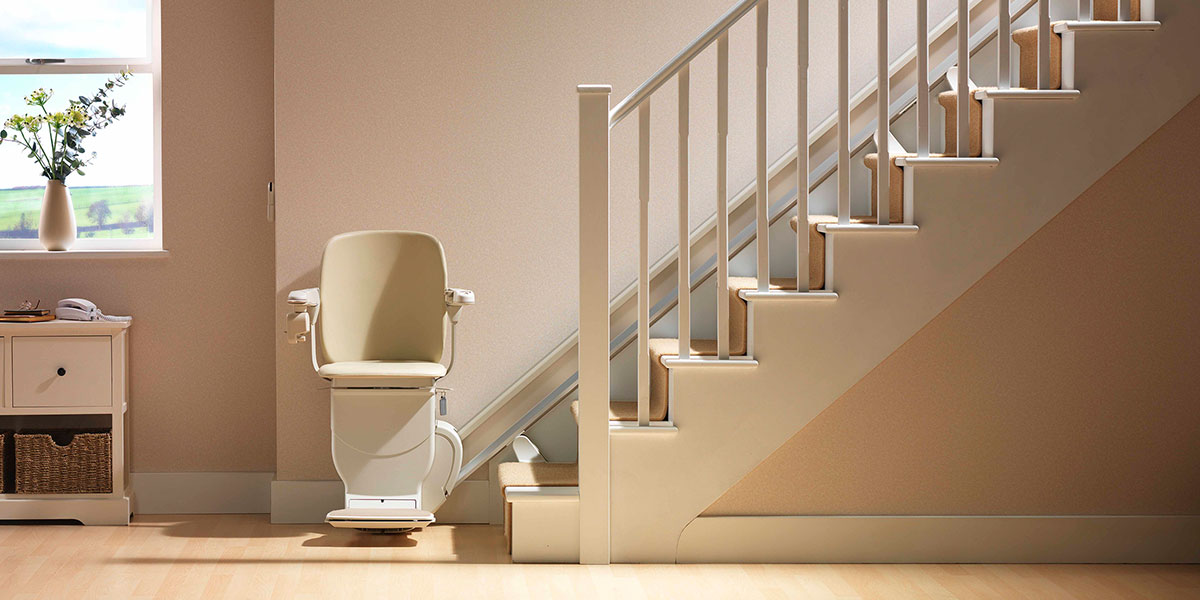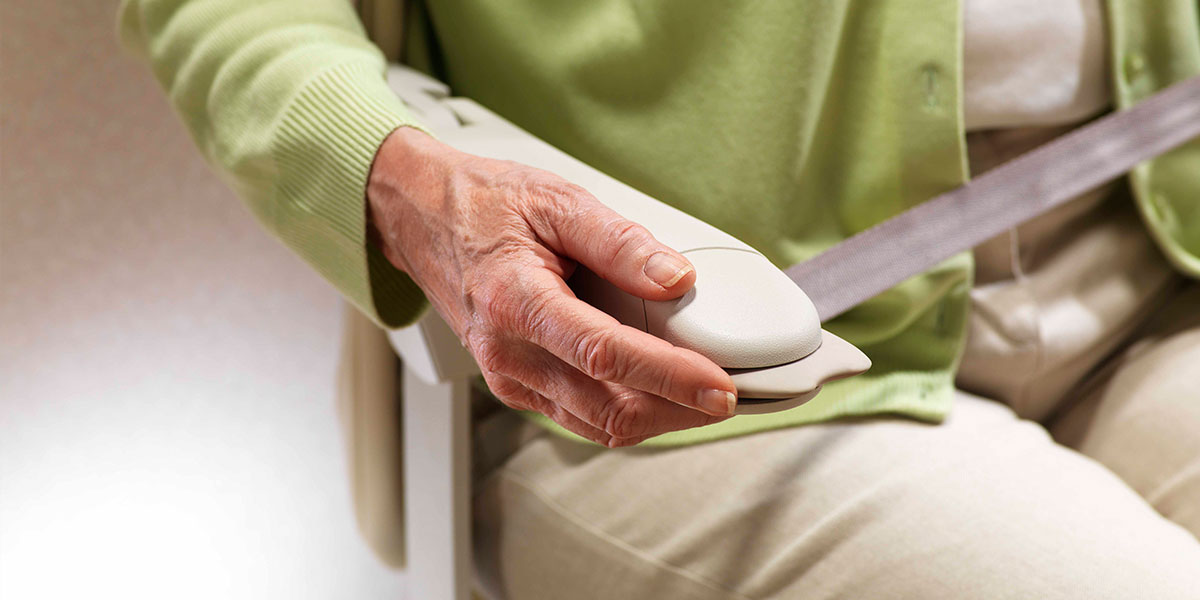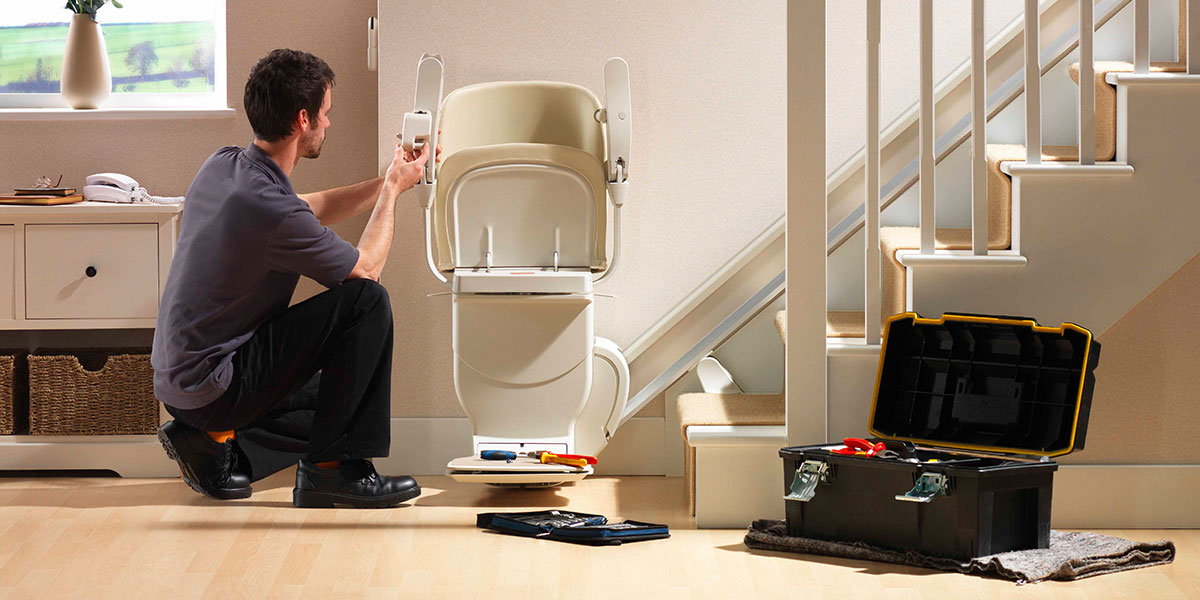Stairlifts: The Complete Guide
How to choose the best stairlift for your home and your needs
Written by Stannah
Stairlifts are a cost-effective way to make your home safer and more accessible. Whether you’re aging in place, planning for the future or recovering from an injury, a stairlift offers access and sustainable independence in your home at an affordable price. Learn more about the different types of stairlifts, their benefits, stairlift installations, warranties and how to buy a stairlift in our complete stairlift buyer’s guide.
Table of Contents
About Stairlifts

An Introduction to Stairlifts
What is a Stairlift?
A Stairlift is a simple piece of accessibility equipment, designed to help people with mobility limitations get up and down their stairs safely. Consisting of a motorized chair that travels along a fixed track, stairlifts can be adapted to a variety of staircase types, including curved and outdoor stairs.
Stairlifts also include a number of convenience and safety features that make it easier (and safer) to use your stairlift. While the basic design remains relatively consistent, these features and the quality of the service provided represent the biggest differences between the various stairlift companies. Let’s take a deeper look at stairlifts and how they work.
Stairlift Dimensions
A common question before buying a stairlift is whether it will fit a given staircase. Thus, the first step of our buying process evolves a free in-home visit, when a Stannah stairlift expert adviser will meet you to know you and your needs, and to measure your stairs.
How a Stairlift Works
Electric Stairlifts
Stairlifts employ a battery-powered rack and pinion drive system that is constantly charged by a nearby outlet at the top or bottom of the stairs. This allows the stairlift to carry its rated load up and downstairs, while the overspeed governor and emergency braking system ensure that the stairlift will never travel faster than it is supposed to (most stairlifts travel at about 18 ft per minute).
Batteries
The main power supplied by the electrical outlet helps the batteries maintain a full charge so that your stairlift is ready to go at all times. However, the stairlift won’t overdraw from your electrical supply and the minimal output means there won’t be any significant impact on your electric bill.
Power Outage
In the event of a power outage, the batteries will continue to operate your stairlift for approximately 20 roundtrips. In this situation, you can usually save battery power by turning off an isolator switch when you aren’t using the stairlift. However, this is only recommended during an outage and it’s important to leave your stairlift switched on the rest of the time.
Replacing the Batteries
Stairlift batteries last between 1 and 5 years, depending on usage and how often the stairlift is left off charge. When it’s time to get them replaced, a professional technician (ideally a representative from the manufacturer or an authorized dealer) can service your batteries for you. Unfortunately, this isn’t something that you can do on your own, as these industrial batteries are stored within the stairlift’s carriage and require technical training to install. However, stairlift batteries are usually covered under an initial warranty or extended service plan.
Weight Capacity
Stairlift weight capacity depends on your staircase type and the model you need for your home. Straight stairlifts can carry heavier loads than curved stairlifts, which operate on a different track that has to adapt to the bends and turns of your staircase. Typically, you can expect weight capacities between 130 kg to 160 Kg for straight stairs and 120 Kg to 135 kg for stairs that turn.
Types of Stairlifts
There are three basic stairlift types: straight, curved and outdoor. Each is suited to a different type of staircase and comes with a unique set of attributes and benefits. Let’s take a look at the different stairlift types, so you can figure out which is right for you.
Straight Stairlifts
Straight stairlifts are the most common type of stairlifts, as they’re designed for simple, straight-run staircases. Usually, these are between 12 and 16 steps, but every house is different and a straight stairlift can be installed on a staircase that’s up to 12 meters (39 feet) long! Thankfully, most staircases are much shorter than that and straight rails can be cut down to the precise length you need, making straight stairlifts are also the most adaptable and reusable type of stairlift.
Since the rail can be cut down to fit on shorter staircases, you can re-sell or donate your stairlift, or simply take it with you if you decide to move. It is important to note that this doesn’t guarantee the new set of stairs will be wide enough for a stairlift and the track cannot be extended if the new staircases is longer than the original.
Curved Stairlifts
Stairs that turn are a more complicated proposition than straight runs. Fortunately, curved stairlifts can handle the bends and turns of almost any staircase. Typically, there are two sorts of curved stairlift: custom-made “bespoke” models and modular stairlifts.
Custom Curved Stairlifts
As the name implies, custom curved stairlifts are designed specifically for your staircase. After measuring your stairs during a free home survey, stairlift professionals will design a custom curved rail that can be manufactured from scratch for a snug fit on your stairs. Custom rails do take a bit longer to manufacture, but the fit on your stairs and the smoothness of the ride are second to none.
Modular Stairlifts
Alternatively, a modular stairlift rail is pieced together from an existing set of rail sections. With these pieces already in stock, a modular stairlift can be installed quickly, but it’s important to note that the installation won’t be as tight, and the ride can be somewhat bumpier. Still, some users might need a quicker installation or simply prefer the look of a modular design. The important thing to understand is that you have options!
Refurbished Stairlifts
Because refurbished stairlifts are pre-owned, it’s important to make sure that you’re working with a reputable company. Buying a second-hand stairlift online or at the local flea market comes with no guarantees, but working with a leading manufacturer or a trusted stairlift dealer ensures that you’ll get a functional stairlift that will serve you well for years to come. The best stairlift companies even carry warranties and service plans for their refurbished stairlifts. If you’re not sure if a refurbished stairlift would be right for you, don’t be afraid to ask!
Who Can Use a Stairlift?
So, now that we’ve covered the basics, the question becomes, “who can use a stairlift?” While most people can operate a stairlift, it’s important to make sure that you have the mobility required to get in and out of the chair safely. Let’s look at a few scenarios and see if a stairlift is right for you.
Seniors
Typically, seniors are the group most associated with stairlifts. And, right enough, they are the leading demographic of stairlift users. It’s only natural that our mobility should decline as we get older and with so many seniors focused on ageing in place, stairlifts provide an attractive alternative to moving or remodelling. For many seniors, their home is their castle. Some have even lived in the same house for decades, so, the prospect of picking up and moving can be hard. Stairlifts make ageing in place a real possibility for these seniors, and their easy functionality and ergonomic designs help seniors save their physical energy for the rest of the day.
People with limited mobility
Of course, you don’t have to be a senior to use a stairlift, anyone with limited mobility can benefit. Stairlifts can help those with chronic conditions, degenerative injuries or even provide relief during a temporary recovery from surgery. The most important factor is being able to get in and out of the chair safely. Even if you struggle to sit down with your knees bent at 90 degrees, there are standing model or “perch” stairlifts that can accommodate your needs.
A Person Who Uses a Wheelchair
Those living with permanent disabilities and people who use wheelchairs might have a harder time using a stairlift, but it really depends on the situation. A stairlift is not a platform lift and cannot carry a wheelchair upstairs. So, for wheelchair users to operate a stairlift, they will need to have wheelchairs stationed near the top and bottom of the stairs. They’ll also need to be able to transfer from their wheelchair to the stairlift’s seat and back again. This can be done with help, but it’s better if the user can perform this task independently. Everyone’s mobility is different and the best way to find out if a stairlift will work for you is to stop by a local showroom and see for yourself.
Pets
While stairlifts are designed specifically for humans, there’s no reason your pet can’t benefit from taking a ride! Cats and small dogs can easily travel up and downstairs with you on the stairlift’s footrest, while your older dog can save some energy, as he enjoys your stairlift’s comfortable seat. It’s important to note that state and local codes prevent pet-friendly modifications from being done to the stairlift, so you will likely have to help your pet get in and out of the chair. Still, pets are a part of the family and what dog doesn’t enjoy going for a ride?
Features & Options

Safety Features & Options
In addition to some of the standard features, many stairlifts can be supplied with options to make them even safer and easier to use.
Safety Sensors
Almost every stairlift on the market is equipped with safety sensors beneath the footrest and on the sides of the motorized carriage. This ensures that the stairlift will come to a gentle, but immediate stop if it encounters an obstruction.
Retractable Rail
Retractable rails are an optional feature for staircases with limited space at the bottom landing. The rail raises and lowers automatically as the chair rides up and down the stairs, clearing room for a door or walkway. This prevents the rail from becoming a tripping hazard or blocking an emergency exit.
Folding Footrest
Just about every major stairlift company carries models that fold up to save space on the stairs, when not in use. The seat and armrests usually flip up manually, but the best companies provide powered footrests. These usually include a button on the armrest that folds the footrest up and down, making it easier to get in and out of the chair and avoiding the need to bend over when folding the footrest (especially important at the top of the stairs).
Seat belt types
Quality seatbelt options can make a big difference for stairlift users. While the industry standard is a simplified “centre-clasp” seatbelt (similar to a backpack strap), companies, like Stannah, go above and beyond with their seatbelt options. Our retractable seatbelt is mounted to the armrest and easy to grasp and fasten, even with arthritic fingers. The ‘Immobilizer’ seat belt prevents the chair from operating l until the seatbelt is engaged. Lap-diagonal and five-point harness seatbelts provide extra restraint over the shoulders and, if needed, between the legs.
Controls
The slimline hand control is mounted to the armrest and allows you to use any part of your hand to operate the stairlift. Simply push and hold the control in the direction that you want to go to move your stairlift. If you let go, the stairlift will stop. The hand control is soft and ergonomically designed for those with limited dexterity. An alternative “rudder” style is also available.
Key Lock
The key lock feature prevents unauthorized use of your stairlift. Simply remove the key and no one else will be able to use the stairlift. When you’re ready to go, replace the key. If you aren’t concerned about others using the stairlift, you can leave the key in all the time.
Types of Seats
There are several types of stairlift seats to choose from. While it’s important to find something comfortable, you should also make sure that you select a seat with the practical features that will suit your needs. Wider chair arms provide extra space and have the added benefit of offering more leverage when you’re getting up from the seated position. Perch/standing models are a good solution for those who struggle to bend their knees or have back problems. You can ride upstairs in a semi-standing position and the hydraulic seat will make getting out of the chair much easier.
In addition to these practical features, many stairlifts offer intriguing style options. You can get vinyl or woven upholstery and choose from a variety of colours. Some stairlifts even come with light or dark wood trim. Once you’ve found the seat that will suit your needs, choose the style options that will suit your home!
Prices and the Buying Process

Stairlift Prices
While a stairlift is a much cheaper option than moving, remodelling or entering an assisted living facility, stairlift prices and installation costs are still important factors to consider. The cost of a stairlift is determined by the shape of your stairs and the unique set of options you need. These options include features like the retractable rail for stairs with a walkway or door at the bottom or the powered swivel seat, which helps the user turn onto the top landing more easily. So, it’s important to speak to a professional to get pricing for your home. In the meantime, here are some stairlift pricing basics to get you started.
Cost-efficiency
Ultimately, the decision to purchase a stairlift is about value. While in some cases, the initial investment can be reasonably high, they’re actually quite low when compared to the prices commonly quoted for a major home remodelling or a month in an assisted living facility. While moving a bedroom down to the ground floor is the cheapest option, is single-story living in a multi-story home really the ideal scenario? A stairlift allows you to enjoy the full use of your home without being impeded by the stairs. When you factor in that quality stairlifts have been known to last upwards of twenty years, there’s really no better value to be had.
How to Buy a Stairlift
Many people are surprised to find how easy buying a stairlift can be. Most staircases are suitable for a stairlift, and questions and other practical concerns can be addressed during a free home visit. During this time, measurements and options are reviewed and a firm price quote is given. When you’re ready, a local team will come and install your stairlift. It’s really as easy as 1, 2, 3.
Assessment
Whether you conducted some online research or spoke to someone over the phone, the next step in the process is a free, in-home assessment of your stairs. During this time, a stairlift expert will come to your home to take a look at your stairs and determine which stairlift is right for you. That means speaking with you to get a better idea of your physical needs and the unique set of options that will work best. That can mean mounting the hand control on the righthand side, rather than the left or fitting your stairlift with a powered swivel to make turning at the top easier, if one side of your body is weaker than the other. For the user, the focus is often on the stairs, but their ability to operate the stairlift is equally important.
Stair Measurements
Once the stairlift expert has a clearer idea of some of the user’s needs, he or she will get to measuring the stairs. This means determining which type of rail will be needed (straight or curved), if the staircase is wide enough and has enough head clearance, and how the rail will finish at the top and bottom of the stairs. They’ll also figure out which side of the stairs work bests and if any obstructions, like a handrail or a door at the top, need to be removed or factored into the stairlift’s design. Once this piece has been completed, you’ll receive a full price quote, usually with a few different options to choose from.
Installation
When you’re ready to move forward, you can schedule your stairlift installation with the company’s local office. At a convenient time, a professional technician will come to your home and install the stairlift to the specifications discussed during the initial home visit. They’ll take their time and make sure everything is done carefully, answering any questions you might have along the way. This process usually takes 3-4 hours, depending on the type of stairlift that you need. Once it’s been installed and thoroughly checked over, the technician will show you how to use the stairlift and leave you with a user guide and a contact number, should you have any additional questions. There’s no invasive remodelling or messy construction work. Just a clean, simple solution.
Tips for Choosing the Right Stairlift
Choosing the right stairlift is all about finding the best value for your situation. Often, the cheapest option isn’t the best solution; neither is the most expensive model. Here are a few important factors that can help you find the right balance for your needs and for your budget.
- Think about how long you want to live in your home. Renting can be a great temporary solution, especially if your recovery is only temporary. But, if you plan on living in your home for longer than 18 months, you’re usually better off purchasing the stairlift outright.
- Consider how your mobility might change. People often think about the stairlift process in terms of their current mobility level. Unfortunately, that can change over time. Make sure you choose a stairlift that can adapt to your needs as they change over time, because if it’s a struggle to use now, it will only get harder down the road.
- Determine the value of the full package. Many online realtors offer enticing prices, with little follow-through on the back end. There’s a big difference between a stairlift in a box delivered to your doorstep and a safe, professional installation backed by a multi-year warranty. When choosing a stairlift (and a stairlift company) it’s important to consider the long-term value. While upfront costs are important, you should always be asking, “What am I getting in the long run?” Whatever factors matter most to you, the answer should include both independence and peace of mind.
Where to Buy a Stairlift
Stannah is recognized as a world leader in the stairlift industry. We’ve helped over 750,000 people get their independence back and our product offerings and customer service are second to none. We’ve been manufacturing stairlifts for over 40 years and continue to improve on our work every day. From our innovative engineers to our knowledgeable sales staff and skilled installation professionals, the Stannah team makes all the difference.
Local Stairlift Service
Stannah and our trusted dealer in Finland – Algol Trehab – provide stairlift service across the country, so no matter where you live, you can find a Stannah to help you live safer at home. Whether you’re working with us directly or one of our trusted dealers you can count on:
- Honest and professional service
- Professional installation and aftercare
- A Stairlift you can rely on
- A company you can trust
- Greater independence at home
Installation and Maintenance

Stairlift Warranties
Stairlift warranties consist of a few different layers of coverage. The principle elements of a stairlift warranty are: Parts Coverage, Labor Coverage, Rail & Motor/gearbox Coverage. Typically, all three of these will be provided for during an initial warranty period, after that, the availability and strength of the warranty will vary significantly from company to company.
Stannah’s class-Leading warranty
If you’re working with us directly, you’ll have access to Stannah’s class-leading stairlift warranty. That means 5 years of coverage on the motor, gearbox and rail.
Stairlift Installation & Maintenance
Once you’ve completed your research, chosen a stairlift company, settled on a set of options and secured funding, it’s time to move forward with your stairlift installation! At Stannah, we make this process as easy as possible. We’ll usually schedule a date with you over the phone when you place your order, and you’ll get a confirmation call the day before installation.
The Stannah installation experience
Whether you’re working with us directly or having a stairlift installed by one of our trusted dealers, you can be sure that you’re getting the full Stannah experience. That means:
- Skilled technicians, who have been thoroughly trained to install your stairlift safely.
- A quality installation, done in a neat and timely fashion.
- Thorough product training, with helpful demonstrations.
- Product literature and access to aftercare service.
Not only are our dealers trained to maintain Stannah’s installation standards, they’re also tasked with upholding our company values. We only work with reputable professionals who share in our commitment to quality craftsmanship, exceptional service and honest sales practices. We put our name on our products and our trust in our dealers. So, whether you’re in our backyard or purchasing your Stannah stairlift through a distributor, you can put your mind at ease.
Battery Maintenance
Once you’ve mastered the basics, upkeep for your stairlift is fairly simple. The most important thing to remember is to manage your stairlift’s battery-life. By making sure that it is always parked at a charge point, you ensure that your stairlift’s batteries are always at top level. In the event of an outage, make sure that your stairlift is turned off to preserve the batteries until power is restored. Once again, regular service and annual maintenance checks will help ensure that you don’t run into battery issues with your stairlift down the line.
Cleaning
You should probably have your stairlift cleaned every few months. Dust, and especially pet dander, can accumulate and impact the operation your stairlift. A light wipe down with non-abrasive cleaning agent should suffice. If you feel uncomfortable cleaning your stairlift, ask a friend, schedule a service call or book an annual maintenance check-up.
Troubleshooting
As you’re getting to know your stairlift, you can find troubleshooting and product guidance through our stairlift user manuals (provided after installation). These complimentary guides will help you get the hang of your stairlift’s operation and provide guidance, should you have any questions. And, of course, you can always call us. We’ll be happy to help!
Contact Stannah
Well, that about covers it! We’ve talked about the different types of stairlifts, how they’re powered, who can use them, the important comfort and safety features, how to buy, where to buy and how much they cost. We’ve discussed installation, warranties and aftercare. Now, it’s up to you! If you’re ready to take the next step, get in touch with us today! We’ll be happy to help you find the right stairlift, one that will help you live independently in the home you love for years to come.
